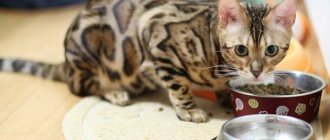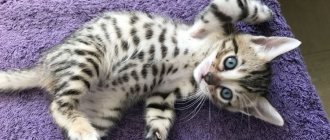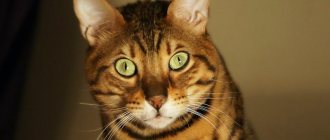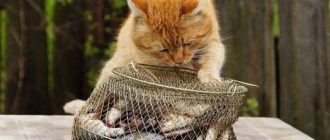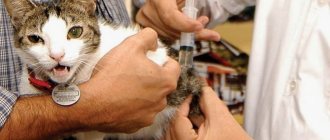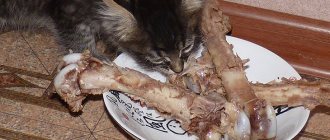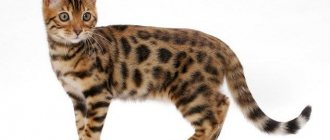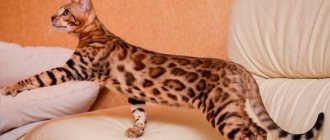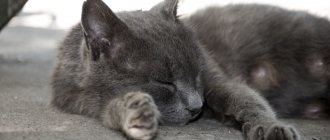About the general health of Bengalis
I would immediately like to debunk the widespread myth that purebred representatives of domestic cats have very weak immunity, that they often get sick, dying from problems that do not threaten street and mongrel animals. On the contrary, breeders select healthy, that is, strong, hardy, individuals not burdened by poor heredity and genetic abnormalities. So the saying “heals like a cat” fully applies to the Bengal purebred breed. But there is another factor: due to the still small population of this particular type of cat, breeding is problematic. Closely related breeding is often practiced, which actually threatens the deterioration of the health of the offspring. In addition, breeding often involves introducing new genes into a pure breed. Sometimes this negatively affects the overall health, especially when the business is handled by an illiterate or irresponsible breeder. Therefore, when planning to buy an expensive kitten, it is better to turn to large nurseries, where they constantly update breeders and do not offer dubious suitors to Bengal cats. Kittens from establishments with experience and an established reputation are usually tough, like their ancestor, the hardy wild Bengal cat.
Standard and appearance
The standards of the American Association (ACFA) state that the final result of breeding Bengals should be to obtain a gentle pet that does not lag behind in physical characteristics from medium-sized cats that live in the forest. Hardy, with the characteristic appearance of wild ancestors, representatives of the breed have slender legs and a magical pattern on their glossy coat.
The Bengal cat, like many other breeds, must meet certain standards. Let's look at the main features:
- The ears are short and set high. Moreover, they have a wide base and rounded ends. On the outside of the ear there is a light-colored spot that looks as if someone pressed on this place with their thumb.
- The cheeks are voluminous, with large whisker pads.
- The body is oblong with clearly defined muscles - a slightly elongated body with a strong skeleton and a long neck with well-developed muscles. Cats are smaller than cats.
- Head. Softened contours of a medium-sized wedge-shaped head. The line from the chin to the nose runs strictly vertical. The mustache pads are convex, the bridge of the nose is wide and straight.
- The pronounced nose has a curved shape and sufficient width.
- The eyes are wide-spaced, large and oval in shape. All colors are acceptable, except for blue - only a lynx point can have it (a snowy bengal with a color point color).
- The length of the coat is very thin, short and glossy. It fits tightly to the body, has no undercoat, and feels almost like satin fabric. In childhood, the fur may be slightly longer. Gray, white or red coat color is allowed. The spots should be evenly distributed throughout the animal's body.
- The tail is of medium length and dense structure. From the beginning to the very base, the tail should be covered with characteristic spots.
- The paws are round in shape with pronounced muscles. The hind limbs are longer than the forelimbs.
- The neck is quite wide and strong. Moreover, it must be completely proportional to the animal’s body.
Colors
The general color palette of the wool background is distinguished by a variety of colors: golden-red, silver-white, reddish-chestnut, bronze-yellow, light cream. The classic (marble tabby color) looks incredibly beautiful. The drawing always comes in a darker shade. A spotted or rosette (preferably) pattern on the sides and back is allowed. The muzzle and forehead are covered with stripes; a necessary condition is the presence of spots on the stomach.
Charcoal and blue colors are considered less suitable for crossing. A large number of animals in which there is no pattern, and the body is evenly covered with striped hairs, is due to an unclear pattern on the blue coat, and dull spots merge with the general background. A charcoal-colored animal visually appears simply dirty.
The spots can have either a random location on the body or horizontal. The pattern is called spotted. Each spot should be sharply outlined and stand out as clearly as possible against the general background. The “decoration” on the neck (necklace) should also be clearly visible.
The presence of rings/rosettes on the tail section is welcome. The presence of spots on the belly is mandatory. There are several varieties of spots: similar to a donut or half of it, like a paw print, like a bunch of grapes, like a dart tip.
The snow color is characterized by a brown pattern, contrasting with the main color of ivory (light and dark shades are acceptable). Eyes are bright aquamarine or blue. The presence of ticking on the body is completely eliminated. The glitter effect “pearl dust” is required.
Symptoms of illnesses in Bengal cats
Each specific disease has its own signs and symptoms, but a number of factors demonstrating the onset of the disease are common, namely:
- the cat has vomited and/or loose stools more than twice within one day;
- there is no stool for more than two days in a row, and then the cat goes to the toilet with blood;
- complaints during urination;
- weak appetite, and even more so a complete refusal to eat;
— the cat eats well, but has become thin;
- sour eyes, copious mucus discharge from the nose;
— bloody discharge from the cat’s loop or the cat poops blood;
- plaque in the ears has become black;
- unhealthy color of the mucous membranes, the appearance of ulcers on them;
- compacted neoplasms on the skin and/or under it.
Together with the unusual behavior of a Bengal cat (anxiety, aggression, or, on the contrary, lethargy to the point of apathy, constant drowsiness), any of the listed signs is a good reason to call a veterinarian and undergo an examination. The likelihood that your pet is seriously ill is high.
How to choose and buy a Bengal kitten
The purchase of kittens usually occurs during the phasing period (at 3 months), when the pattern fades or reappears on the coat. It will finally acquire its color and clarity only by 8-10 months. The phasing period is evidence of the presence of wild roots in the kitten. The breeder is obliged to warn everyone who wants to purchase a kitten about this phenomenon.
It is important to examine the baby yourself before purchasing. If he doesn’t hiss, isn’t afraid, and you can hold him in your arms, then everything is fine. Carefully evaluate the mother's drawing; if her color is blurred, it can be passed on to the kids. The breeder must have all certificates of vaccinations and anthelmintic use. You should request a kitten card, which will give you the opportunity to open access to the family tree in the future.
Price
Prices for kittens vary greatly. It all depends on the region of residence and ancestry. You can buy an animal for either five or fifty thousand rubles. Thus, the average cost is around twenty thousand.
Pros and cons - who is it suitable for?
People with a calm character who are used to sitting in front of the TV in the evening, elderly people, and families with infants and children under school age should avoid purchasing this breed of cat. The owner must have strong nerves. Animals of this breed have excessive sexual activity, cats constantly mark their territory, and cats “sing” their songs. The problem can be solved by timely sterilization or castration.
They need to always be the center of attention. Active, energetic, lively cats should spend as much time as possible with their owner, otherwise they will be very sad and have a hard time being separated from a person. When the owner is absent for a long time, he may begin to destroy everything in the house simply out of boredom. They always need someone nearby.
A high concrete fence, a round post, catching a fly or a bird on the fly is not a problem for a Bengal. They have a well-developed muscular system, strong paws with tenacious claws, and their curious nature does not allow them to quit halfway through the task. They simply need a “sports” corner to satisfy the need for an active lifestyle.
Their genes determine their love for water. The beloved owner went to the shower - no problem! You can go with him. Kittens can endlessly throw toys and other objects within their reach into the water. An excellent solution for the owner would be to install a fountain or any other decorative water feature in the house. You can even take your pet for a walk by the water.
The main misconception is that Bengalis are prone to aggression. This is absolutely not true. Most representatives of the breed are intelligent and friendly. Aggressive and independent animals grow up in enclosures, without human contact. Those cats who have known the love and affection of their owner from the first months of life will always be playful, meek and flexible. They will never attack their owner or another family member.
However, Bengal cats are very jealous. They are absolute owners and quite selfish. There should be no disregard for oneself or disposition towards another cat on the part of the owner. But, if you start raising her from the very beginning, she will be able to live with other pets as a leader.
Interestingly, they love dogs and playing with them. This may be due to a characteristic characteristic of these two species: protection of their territory. He perfectly distinguishes his family members from strangers, and will not fall into their hands. They love to have long “conversations” with their owner, making sounds that are more like barking, chirping and cooing.
If a small child appears in a house where a Bengal already lives, he will treat the little owner with special tenderness, and over time can become an excellent nanny. These active ones really like the noisy, moving, rattling and rustling children's toys that fill the whole house with the arrival of the baby. Owners may well purchase toys for their animals in specialized children's stores.
Popularity of the breed
Real lovers of Bengal cats are residents of the USA and Canada. The largest number of nurseries are located on the territory of these countries. Despite the rarity and high cost of the breed, it is also popular in Russia, where many nurseries are also located. To say they are popular is an understatement. You can call it wildly popular, and breeding in Russia only increases the advantages of this breed.
What most people know about this breed is that they have an extraordinary appearance and an equally extraordinary price. This is what allowed them to get on the page of the Guinness Book of Records. The largest sum in history was paid for a second-generation Bengali named Kato, who was purchased in 1998 by a woman from the capital of England. S. Jackson paid $41,000 for this cat. The cat itself, whose breeder is Lord K. Esmond Gay, was born in England.
Main ailments of Bengal cats
The weakest point in the body of Bengals is the gastrointestinal tract - this is the genetics of this breed. According to statistics, almost every representative of the Bengal breed suffered from such problems at least a couple of times in their life. More often than other manifestations, Bengal cats and cats experience indigestion due to food poisoning and changes in food. Having an expensive Bengal pet, to put it mildly, it is unwise to feed the animal cheap food from supermarkets, which experts have rightly dubbed cat poison. In addition, indigestion in a sensitive stomach leads to inflammatory bowel diseases, diarrhea appears, blood in the stool, and the Bengal cat’s body temperature rises.
Story
The Bengal breed of domestic cats appeared thanks to the crossing of the Asian leopard cat Prionailurus bengalensis (which was commercially available 70 years ago) and the domestic shorthair cat. Jean Mill, a breeder from California, was the first to carry out such a cross, but not with the goal of creating a new breed. Jean acquired a female wild cat in Bangkok, which she named Malaysia, and allowed her to interact with her black pet cat. She did not expect that the animals would mate and to her surprise, in 1963 the spotted cat Kin-Kin was born. However, family circumstances forced Jean to stop working on breeding cats. She gave Malaysia to the zoo, and Kin-Kin got pneumonia and died.
Almost at the same time, Dr. Willard Centerwall also began to conduct similar crossbreeding of cats at Loyola University. Prionailurus bengalensis had strong immunity to feline leukemia virus, so scientists wondered whether this trait could be passed on to hybrid offspring.
For various breeders, hybrid cats have become interesting as a breed. Jean Mill was one of them, because despite personal problems, she returned to breeding. Jean purchased 9 first-line (F1) hybrid females from Dr. Centerwall and then began searching for males for them. This is where the creation of the Bengal domestic cat breed began.
Bengals today are considered the same as domestic cats. A true purebred cat must be at least in the fourth (F4) generation from any wild ancestor. The International Cat Association granted experimental status to the breed in 1983, followed by full recognition in 1991. This breed is also recognized by the American Cat Fanciers Association, the Canadian Cat Association and the United Felines. Bengal cats were so popular that a British woman paid over $50,000 for her Bengal cat in 1990.
Other diseases most commonly reported in Bengal cats
The list of other ailments recorded in Bengals is small, but recently it has been noted that they do not occur so rarely, almost on a par with problems of the stomach, esophagus, and intestines.
Cardiology
Pathology of the structure of the heart - hypertrophic cardiomyopathy is caused by the fact that one of the walls of the “motor” that pumps blood is thicker than the others. This causes disruption of all heart activity, leads to many problems with general health, and ends in sudden death. The pathology often does not manifest itself in any way, and the danger lies in the absence of early symptoms. Therefore, it is important for owners of Bengal cats who notice the lethargy of the animal or symptoms of severe fatigue after active games to conduct a heart examination using ultrasound and ECG. Such examination should be carried out regularly for all Bengal cats up to the age of five. The causes of cardiomyopathy have not yet been reliably determined, but genetic and hereditary factors play a decisive role. On average, the percentage of Bengals with this disease is from 25 to 30-plus, which puts mini-leopards on the penultimate line in the list of ten known and recognized breeds prone to heart disease (the list is now headed by Maine Coons).
Genetic syndromes
Flat chest syndrome (FCK) is a condition common in newborn kittens. This serious genetic pathology in the Bengal breed has become even more common than cardiomyopathy. A disturbance in the configuration of the chest, when the ribs compress the chest cavity, interferes with normal breathing. Individuals with a severe stage of the syndrome die in the first days or weeks after birth (life spans of 10 days and 3 weeks are considered critical). If this does not happen, then the animal may continue to develop as expected, or may have a “sunken sternum” defect, which does not particularly affect health. With FCK, the ribs of the sternum are either completely flat below or funnel-shaped, curving into the middle of the chest. At exhibitions, such animals, even with all other brilliant indicators, are rejected.
Bengal kittens and young one-year-old cats are susceptible to dry nose syndrome. Visually, symptoms are revealed by cracks and crusts on the animal’s nose. Sores, if they are not lubricated with healing ointments, can gradually turn into ulcers.
The immune system
Poor functioning of the immune system is a problem inherent in lines where multiple matings between direct and very close relatives were allowed. This violation does not occur if the breeder occasionally acquires a stud or breeding cat from other breeding grounds. By tracing the pedigree of a kitten when purchasing a kitten, you can avoid the hassle of additional vaccinations and procedures such as deworming.
Like other cat breeds, Bengals have to suffer, albeit infrequently, from leukemia, as well as from urolithiasis, especially in regions where the water the cat drinks is highly hard. Unsterilized cats and cats may experience hormonal disorders, and those that eat soft, including natural food, suffer from tartar deposits. Cancer is a common problem for older pets.
Cat food
It is best to feed your Bengal cat special dry food, which is sold in zoological stores. They contain the required amount of nutrients and minerals that are necessary for the body. In addition, such foods do not harm gums and teeth, so they are the best option.
You need to feed three or four times a day. The main thing is not to overfeed. Obese cats have an extremely short lifespan.
If your pet eats dry food, it is very important that he drinks enough liquid. Animals that drink little water are susceptible to urolithiasis. It is worth remembering that they love to splash in the water, so the drinking bowl can be turned over. You need to constantly monitor the liquid level in the bowl.
If you notice that your pet drinks very little, you can try purchasing special drinking bowls in the form of a miniature fountain. The sound of rushing water will cause an involuntary desire to quench your thirst.
If you have firmly decided that you will feed your cat exclusively natural products, then you should adhere to several rules. Their main diet is meat. Beef or rabbit meat is most suitable. Fish should be given, but not more often than twice a week. At the same time, you should avoid small river fish with a lot of bones.
In addition to meat products, you should add fermented milk products or low-fat cream to your diet. Vegetables are also an important part of the daily diet. Cats enjoy eating cucumbers, tomatoes and bell peppers.
After they have developed a stable menu of natural products, they definitely need to go to the veterinarian for a consultation. Perhaps the list of products will need to be expanded or additional vitamins purchased. Only a specialist can say this for sure.
About the prevention of diseases in Bengal cats
Reasonable prevention is always simpler and cheaper than treatment, not to mention the suffering of the pet. In addition to mandatory vaccinations, Bengal cats need to receive comprehensive specific vaccinations against the most common feline infections. It is easy for owners who truly love their tails to adhere to the following rules:
- give only high-quality fresh food, be it industrial or natural food; do not experiment too often with dishes unfamiliar to the cat, do not change the diet suddenly;
— drink purified water, changing it in the bowl several times a day;
- fight parasites - carry out deworming once a quarter, even if the animal is completely domestic, because household members can bring fleas from the street;
- monitor changes in the animal’s condition - as soon as the pet “suddenly” begins to behave differently, eats poorly or drinks too much, or the condition of the fur has worsened, you need to see a veterinarian.
Professionals are unanimous in their opinion that if a Bengal cat or cat is not involved in breeding work, they need early sterilization. It is most effective for health when the procedure is performed before the male or female reaches puberty. A person’s statements and actions from the series “let her give birth”, or “almost doesn’t mark”, or “give pills - doesn’t scream” are irresponsible.
Breeders and owners have always been pleased with the naturally good health and good immunity of representatives of the Bengal cat breed. Representatives of the species are not very allergenic to humans, but they themselves are not particularly allergic. Poor health, and sometimes even cardiac arrest, can be caused by certain medications - for example, during anesthesia during operations.
The natural endurance of the breed, the attentive attitude of the owners are the prerequisites and conditions that guarantee a carefree healthy life for Bengals throughout the 14-16 years of their cat life.
Read all about the Bengal breed in the Main article
Character trait
Over the course of a long time, the breed was improved. The goal of the breeders was to obtain non-aggressive and courageous offspring. All cowardly kittens were considered a marriage. So the line turned out more and more clean.
The Bengal cat is famous for its grace, calmness, love of communication, tenderness and devotion.
However, “wild blood” also makes itself felt. The animal is very dexterous, quick, and intelligent. Cats love active games.
Their favorite pastime is running, because the “predator’s blood” still flows through their vessels. So don't be surprised if your pet takes over cabinets, sofas or shelves.
The Bengal cat is very smart, she is able to remember what her owner does and then reproduce it.
Opening doors or windows, turning on or off the light, flushing the toilet - all these are trivial tasks for representatives of this breed.
They love water and enjoy swimming or keeping their owner company.
Although the cat is domestic, it still has the instinct responsible for protecting its “leader”. Having become a real leader for your cat, you don’t have to worry about your “safety.”
A Bengal cat will protect you at the cost of its life.
The cat's predatory instinct will not allow a single mouse in the house to even run past. But it’s somehow stupid to use a pet that costs thousands of dollars for such purposes.
You can admire a domesticated leopard for hours, participate in exhibitions, but never use it as a mouse or rat trap.
Take care of your fingers, otherwise the cat may bite you while playing. And don’t hold it in your arms for a long time, the Bengali doesn’t like it. Although loneliness is not for a representative of this breed. Everything in moderation.
